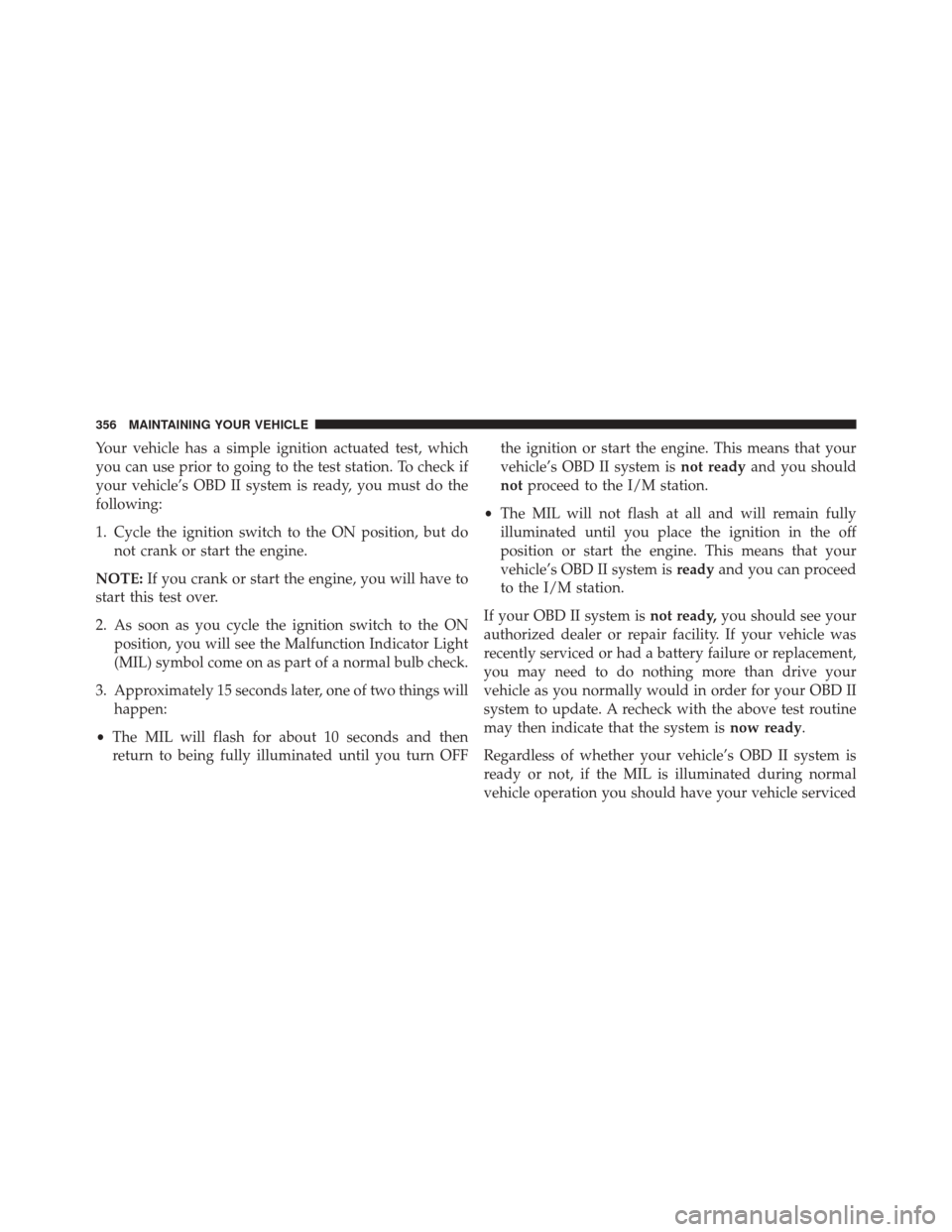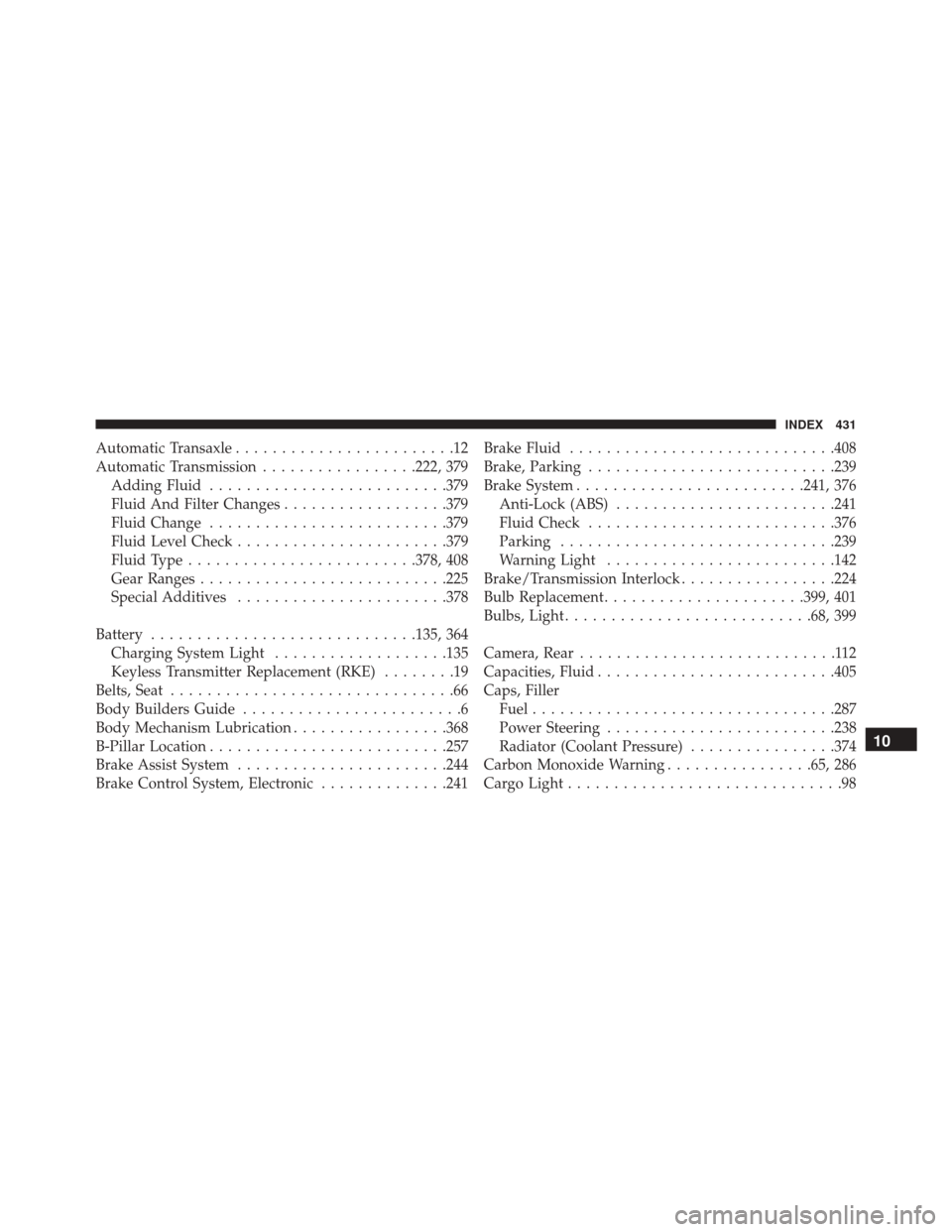Page 11 of 448
THINGS TO KNOW BEFORE STARTING YOUR VEHICLE
CONTENTS
�A WORD ABOUT YOUR KEYS .............11
▫ Ignition Key Removal ...................12
▫ Locking Doors With A Key ...............13
▫ Key-In-Ignition Reminder ................14
� SENTRY KEY ..........................14
▫ Replacement Keys .....................15
▫ General Information ....................15
� VEHICLE SECURITY ALARM — IF
EQUIPPED ............................15
▫ Rearming Of The System .................16 ▫
To Arm The System .....................16
▫ To Disarm The System ...................16
▫ Security System Manual Override ...........17
� ILLUMINATED ENTRY ...................17
� REMOTE KEYLESS ENTRY (RKE) ............17
▫ To Unlock The Doors ....................18
▫ To Lock The Doors .....................18
▫ Programming Additional Transmitters ........18
▫ Transmitter Battery Replacement ...........19
▫ General Information ....................20
2
Page 21 of 448
Transmitter Battery Replacement
NOTE:Perchlorate Material – special handling may ap-
ply. See www.dtsc.ca.gov/hazardouswaste/perchlorate
The recommended replacement battery is CR2032.
1. Push the mechanical key release button and release the mechanical key to access the battery case screw lo-
cated on the side of the Key Fob.
2. Rotate the screw located on the side of the Key Fob using a small screwdriver.
3. Take out the battery case. Remove and replace thebattery observing its polarity.
4. Refit the battery case inside the Key Fob and turn the screw to lock it into place.
Key Fob Screw Location
2
THINGS TO KNOW BEFORE STARTING YOUR VEHICLE 19
Page 353 of 448
MAINTAINING YOUR VEHICLE
CONTENTS
�ENGINE COMPARTMENT — 3.6L ..........353
� ONBOARD DIAGNOSTIC SYSTEM — OBD II . .354
▫ Loose Fuel Filler Cap Message ............355
� EMISSIONS INSPECTION AND MAINTENANCE
PROGRAMS ......................... .355
� REPLACEMENT PARTS ..................357
� DEALER SERVICE ..................... .357
� MAINTENANCE PROCEDURES ...........357
▫ Engine Oil ......................... .358
▫ Engine Oil Filter ..................... .361▫
Engine Air Cleaner Filter ................361
▫ Exhaust System ..................... .362
▫ Maintenance-Free Battery ...............364
▫ Air Conditioner Maintenance .............366
▫ Body Lubrication .....................368
▫ Windshield Wiper Blades ...............369
▫ Cooling System ..................... .370
▫ Brake System ....................... .376
▫ Automatic Transmission
(3.6L Gasoline Engine Only) ..............378
7
Page 358 of 448

Your vehicle has a simple ignition actuated test, which
you can use prior to going to the test station. To check if
your vehicle’s OBD II system is ready, you must do the
following:
1. Cycle the ignition switch to the ON position, but donot crank or start the engine.
NOTE: If you crank or start the engine, you will have to
start this test over.
2. As soon as you cycle the ignition switch to the ON position, you will see the Malfunction Indicator Light
(MIL) symbol come on as part of a normal bulb check.
3. Approximately 15 seconds later, one of two things will happen:
• The MIL will flash for about 10 seconds and then
return to being fully illuminated until you turn OFF the ignition or start the engine. This means that your
vehicle’s OBD II system is
not readyand you should
not proceed to the I/M station.
• The MIL will not flash at all and will remain fully
illuminated until you place the ignition in the off
position or start the engine. This means that your
vehicle’s OBD II system is readyand you can proceed
to the I/M station.
If your OBD II system is not ready,you should see your
authorized dealer or repair facility. If your vehicle was
recently serviced or had a battery failure or replacement,
you may need to do nothing more than drive your
vehicle as you normally would in order for your OBD II
system to update. A recheck with the above test routine
may then indicate that the system is now ready.
Regardless of whether your vehicle’s OBD II system is
ready or not, if the MIL is illuminated during normal
vehicle operation you should have your vehicle serviced
356 MAINTAINING YOUR VEHICLE
Page 433 of 448

Automatic Transaxle........................12
Automatic Transmission .................222, 379
Adding Fluid ......................... .379
Fluid And Filter Changes ..................379
Fluid Change ......................... .379
Fluid Level Check ...................... .379
Fluid Type ........................ .378, 408
Gear Ranges .......................... .225
Special Additives ...................... .378
Battery ............................ .135, 364
Charging System Light ...................135
Keyless Transmitter Replacement (RKE) ........19
Belts, Seat ...............................66
Body Builders Guide ........................6
Body Mechanism Lubrication .................368
B-Pillar Location ......................... .257
Brake Assist System ...................... .244
Brake Control System, Electronic ..............241Brake Fluid
............................ .408
Brake, Parking .......................... .239
Brake System ........................ .241, 376
Anti-Lock (ABS) ....................... .241
Fluid Check .......................... .376
Parking ............................. .239
Warning Light ........................ .142
Brake/Transmission Interlock .................224
Bulb Replacement ..................... .399, 401
Bulbs, Light .......................... .68, 399
Camera, Rear ............................112
Capacities, Fluid ......................... .405
Caps, Filler Fuel ................................ .287
Power Steering ........................ .238
Radiator (Coolant Pressure) ................374
Carbon Monoxide Warning ................65, 286
Cargo Light ..............................98
10
INDEX 431